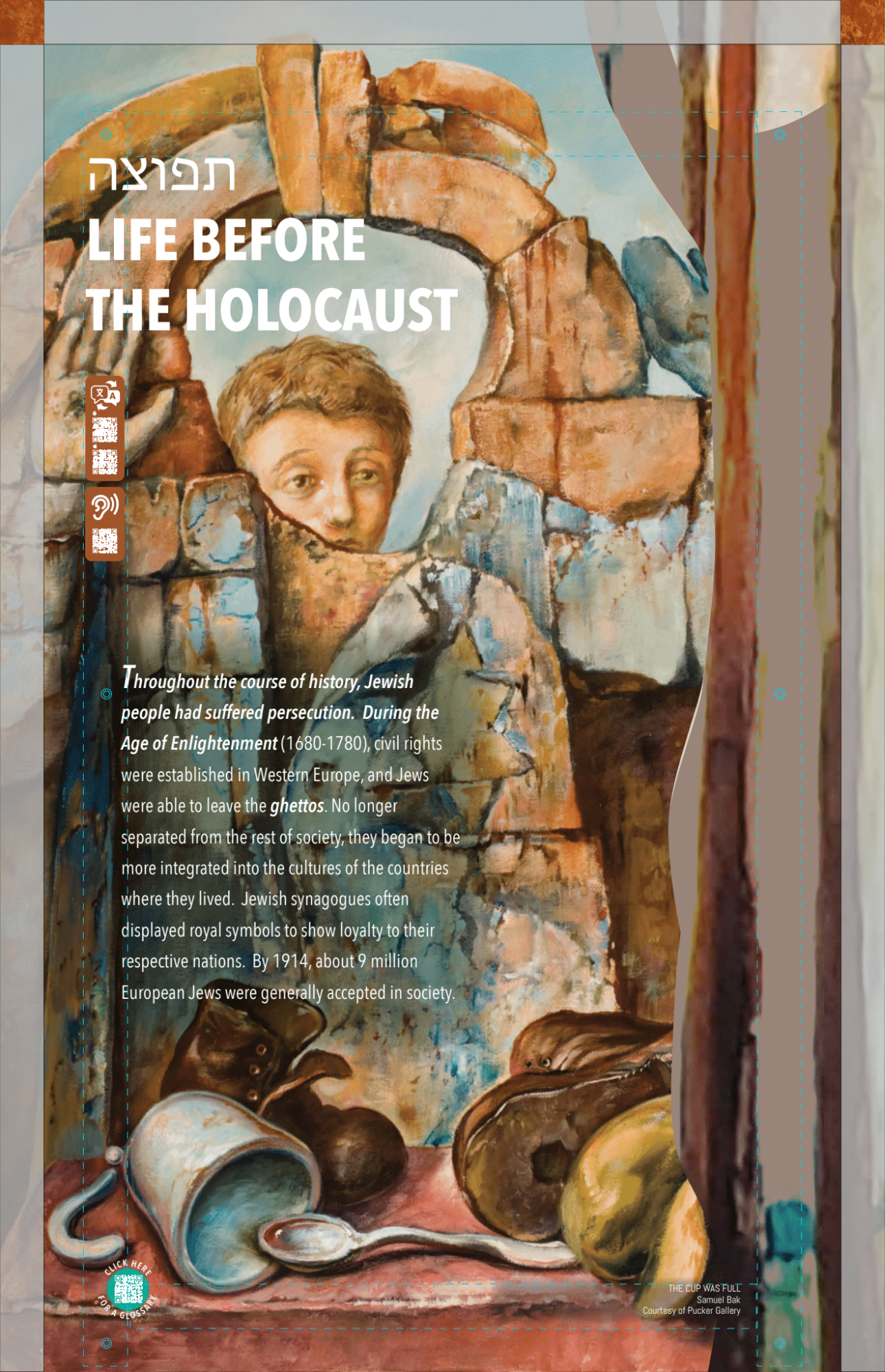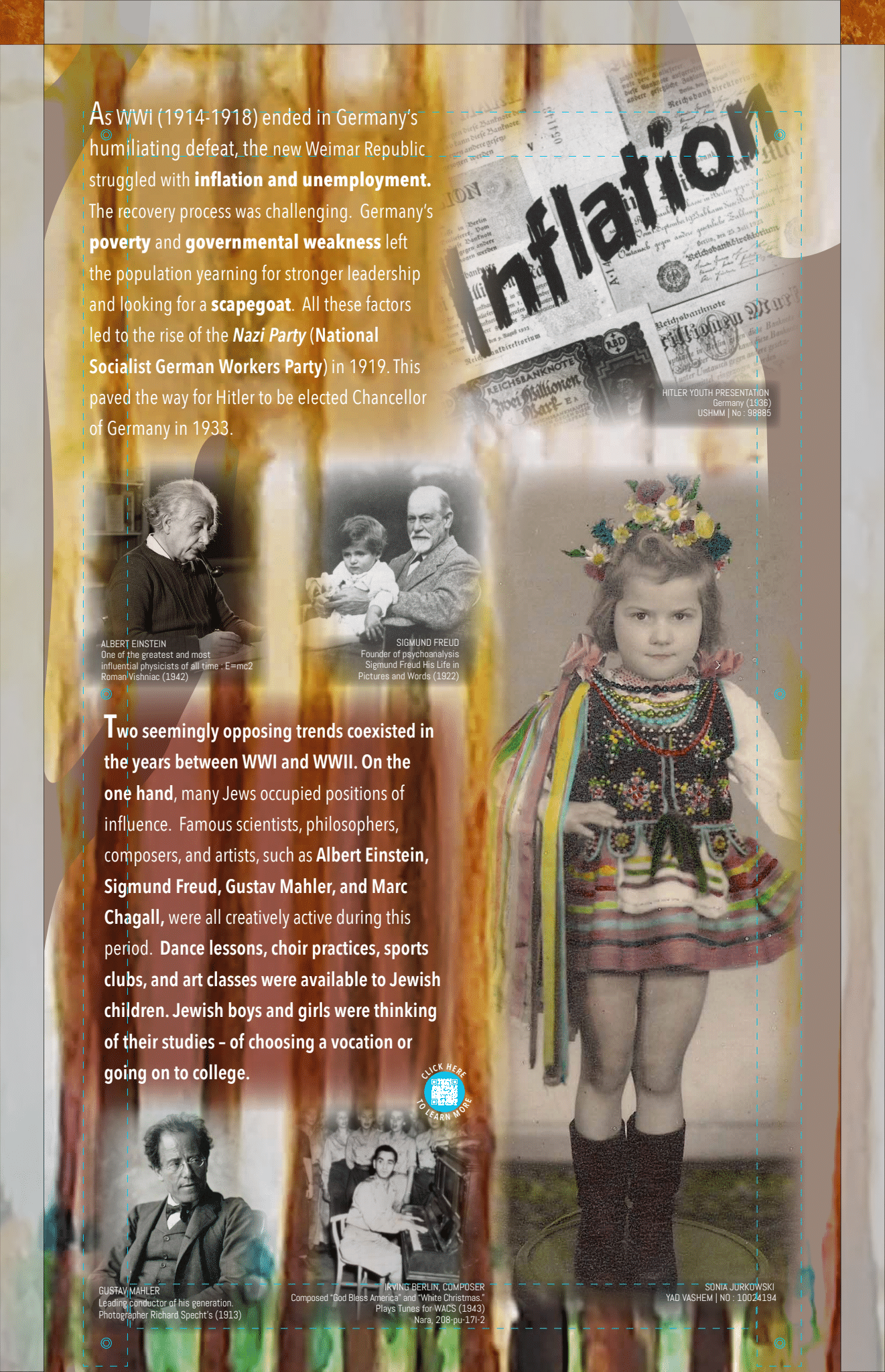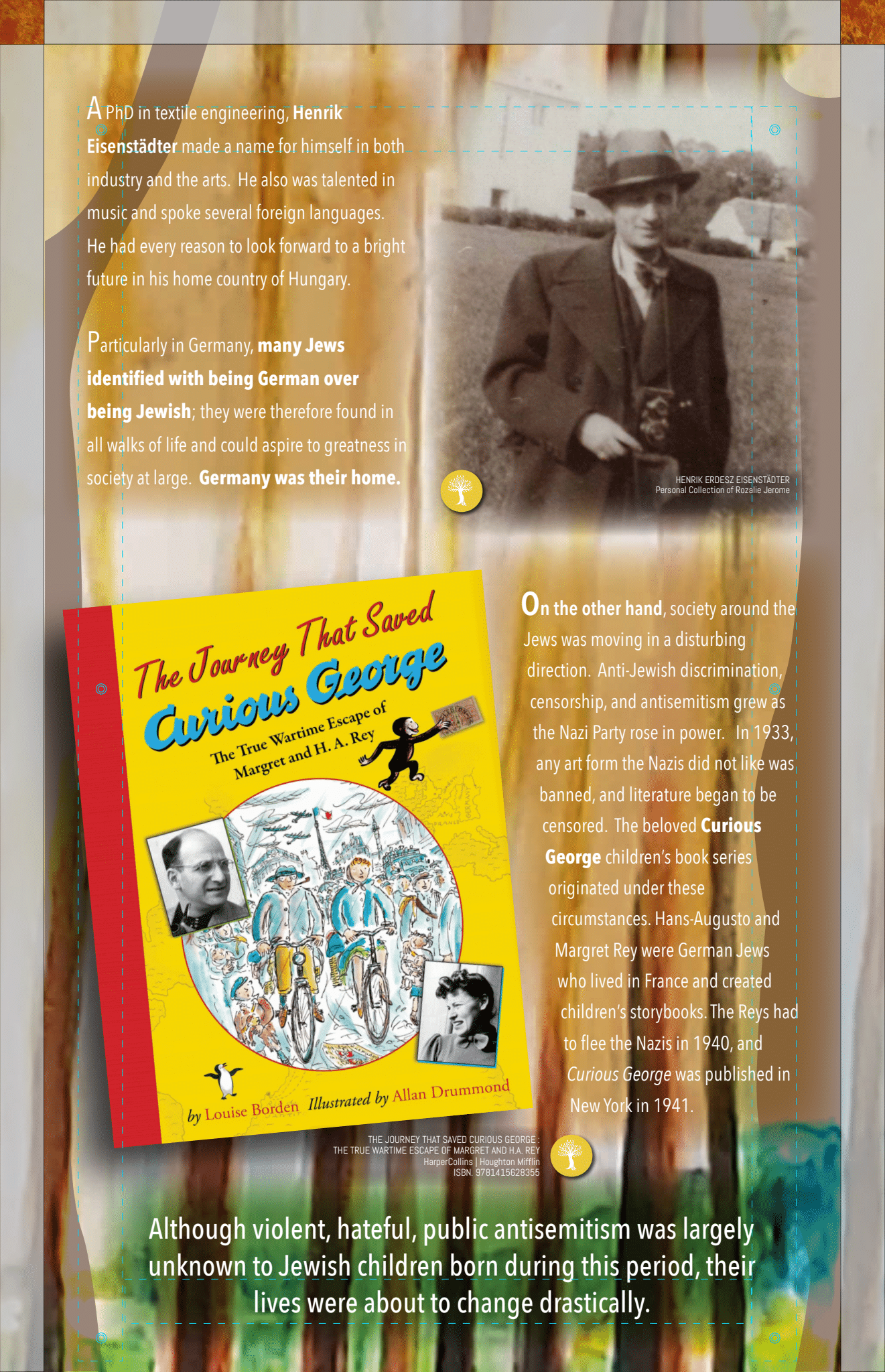exhibit 2 exposition
Life before the Holocaust – Business & Everyday Pleasures
by Dr. Susanna Kokkonen
“And his sons would go and feast in their houses, each on his appointed day, and would send and invite their three sisters to eat and drink with them.” Job 1:4 (NKJV)
In-depth materials – click menu items to jump to the subject:
Enlightenment Era
The position of the Jews started changing during the Age of Enlightenment (1680-1780). Enlightenment was an intellectual movement to establish human and civil rights. Whilst the Enlightenment was not free of Antisemitism, the movement led to Jewish Communities receiving their civil rights in Western Europe.
Antisemitism now changed. It became a kind of socio-economic envy and an accusation of dual loyalty. Jews were accused of having caused the societal changes some citizens disliked. Many antisemitic accusations and conspiracy theories that still exist originated in that period.
One well-known post-Enlightenment case was that of a Jewish army officer in the French army. Alfred Dreyfus (1859-1935) was accused of treason. Despite his innocence, he was condemned with clearly antisemitic undertones. His innocence was acknowledged only years later.
Dreyfus’s mistrial and ordeal convinced a Hungarian Jewish journalist Theodor Herzl (1860-1904) that there was a need for a Jewish state. Herzl consequently created the organized Zionist movement.

Jews Enter Societies
From the Enlightenment on, Jews became a strong cultural and even political element in the European society. Even in Eastern Europe, where Jewish communities were typically more Orthodox, spoke Yiddish and lived more secluded in Jewish villages known as shtetels, there was more openness.
In Germany, many Jews were part of an open-minded Reform movement. Art, literature, music, and science all became fields where Jewish individuals could excel in the society at large. At the same time, Jewish identity was maintained as a religious or cultural identity by for instance communal celebrations of religious holidays.
Synagogues in Europe often had symbols, such as vultures integrated into their decorations. Vultures were symbols of many royal houses, and this was a way to honor them as loyal citizens. This was done in accordance with Jeremiah’s instruction for the Babylonian Exile; later to be modelled in all exiled Jewish communities: “And seek the peace of the city where I have caused you to be carried away captive and pray to the Lord for it…” (Jeremiah 29:7)

Famous Jewish Figures of Culture (Part 1)
There were notable cases of conversions as well as attempts to show that Judaism could coexist with the Enlightenment. The German Jewish writer and philosopher Moses Mendelsohn (1729-1786) exemplified this with his famous choice of “Mendelsohn” over his original name “ben Mendel”, both meaning “Son of Mendel”.
Gustav Mahler was born in Austria in 1860. Despite his poor background, he studied at the Vienna University. From provincial orchestras, he rose to become the conductor and director of the Vienna Court Opera in 1897. This is when he composed his famous 8th Symphony a.k.a the ‘Symphony of a Thousand’.
He later moved to the United States, where he directed New York Philharmonic and the Metropolitan Opera. He composed until his death in 1911. His wife Alma was the daughter of Emil Schindler, a famous painter at the Vienna Court.
Gustav’s niece Alma Rose (1906-1944) was one the most talented violinists of her time. She ended up in Auschwitz where she had to conduct an orchestra of female musicians. She died in unclear circumstances, possibly of a poisoning in 1944. Quite possibly she was the only Jewish prisoner, whose death the SS and other Germans recognized, as such.
Felix Mendehlssohn, born in 1809 as the grandson of famous Berlin philosopher Moses Mendelssohn, was baptized at the age of seven. This act shows the limits of Jewish acceptance – his father believed as a Christin he would have better chances at success. This talented composer nevertheless had to face criticism of his music because he was a Jew. At the same time, his defenders always felt that he was a faithful Lutheran.
After his death in 1847, the composer Richard Wagner (1813-1883), later a favorite of the Nazi Party, wrote against Mendelssohn in clearly antisemitic tones.
An antisemitic writing that came to have much influence around the world is Russian mystic Sergei Nilus’ (1862-1929) book “Protocols of the Elders of Zion”. The book came out in the Tzarist time when antisemitism was an official policy. It describes an imaginary meeting of twelve Jews, easily understood to mean the twelve tribes. The meeting is about controlling the world. Nilus’ book spread like wildfire and is still often considered evidence of a Jewish plot to control the world.
Interwar Period
By WWI, the nine million Jews of Europe were mostly well-integrated into their societies. At WWI, Jews fought in their national armies in an exemplary way. In Germany itself, c. 100 000 Jews fought in the German army; many returned as decorated WWI veterans. It was in 1917 that the Balfour Declaration was given by the British Government opening the way for the establishment of a Jewish State in the British Mandate of Palestine. Arthur Balfour (1848-1930), a respected British statesman wrote the letter to Lionel Walter Rothschild (1868-1937) leader of the Anglo-Jewish Community stating that His Majesty’s Government supported the establishment of a national home for the Jewish people in Palestine.
Famous Jewish Figures of Culture (Part 2)
The interwar period was a time of great creativity. Albert Einstein (1879-1955), Sigmund Freud (1856-1939) and Marc Chagall all created during this period and were eventually forced to escape the Nazis.
Albert Einstein was born in Ulm, Germany in 1879 to a secular Jewish family. His schooling was scattered due to having to move many times. Later, he was rejected by universities. At first, his papers were rejected by scientific journals too. Later, however, Einstein developed the Theory of Relativity. In 1921, he was awarded the Nobel Prize for Physics. Einstein as a famous Jew became a target for the Nazis. He left Germany in 1932 never to go back.
Sigmund Freud born in 1856 to a Jewish family, graduated from the Medical School of Vienna University. He became a neurologist and world-famous founder of psychoanalysis. In 1933 in their book burnings Nazis included Freud’s books in what they hated. Freud escaped the Nazis to London where he died in 1939.
Marc Chagall is quite probably the most famous of Jewish painters. Born in a poor Jewish shtetel in Belorussia in 1887, he eventually moved to St. Petersburg, then to Paris. Chagall famously painted either the Bible or love. He never forgot his origins and kept painting scenes of Jewish life in his village. He was helped to the safety of the United States in 1941 when the Nazis overtook Paris.
Bauhaus, a modernist school of art was active in Germany from 1919 until the Nazis banned it in 1933. Any art form the Nazis did not like was simply banned. Tellingly, much Bauhaus architecture is available in today’s Tel Aviv.

Irwin Berlin, as was said about him “has no place in American music – he is American music”. In reality the beloved composer of ‘White Christmas’ was born in Belorussia as Israel Beilin in 1888. As the family immigrated to America, he worked odd jobs. His first international hit came out in 1911. He supported American troops and was awarded Army’s Medal of Merit by President Truman in 1945. President Eisenhower awarded him the Congressional Gold Medal in 1954. He became a favorite Hollywood and Broadway composer. He died at the age of 101 in 1989.
The beloved story of ‘Curious George’ originated in these same circumstances. Hans-Augusto Rey, originally Reyersbach (1898-1977) and Margaret Rey (1906-1996) were German Jews, who lived in Paris and created children’s picture books. They had to flee the Nazis and had Curious George published in New York in 1941.
For Jewish children living at that time, there were dancing lessons, choir practices, sport clubs and art education to attend. Jewish boys and girls were thinking of their studies; of may be studying a vocation or going on to university. Jews were to be found in all walks of life. One could be a Zionist and attend Zionist activities or one could aspire to greatness in the society at large. Unprecedented opportunities were within reach of a young person. As testified by memoirs, many Jewish children and youth in Germany had good lives, which they hoped would go on forever as they were. But the society around them was changing to a worrying direction.
Weimar Republic
Several Jews were part of the new Weimar Republic (1918-1933), a democratic government. This led to a situation where terrible post-war problems, such as inflation and political instability were very much connected with the Jews. The Weimar Republic increasingly failed to create economic stability. At the same time, many Germans felt that the conditions of demilitarization, territorial compromises and war reparations imposed on them by the Versailles Peace Treaty, were too harsh. This gave prominence to the Dolchstoss Legende, Stab-in-the-Back Myth, whereby Germany had been defeated due to internal betrayal – especially by the Jews.
We can only guess at the uncertainty felt by German Jews before right before 1933. The strong German-Jewish identity they were so proud of needed to be re-examined, as the society changed. Whether living in Eastern or Western Europe; whether religious or secular; whether well-educated or poorer, they all were soon going to face destruction.
The interesting thing to note is that during the inter-war period two seemingly opposing trends existed in the society. First, Jews became integrated in the society in an unprecedented manner occupying positions of influence. Second, Antisemitism rose in parallel meaning that in the inter-war period, there were many antisemitic parties and movements in the German society. There was also the fact that during this period, poor Jews from Eastern Europe Ostjuden, wearing traditional garments, started arriving in Germany. Their presence was now used in intensifying antisemitic propaganda. In some ways, this all culminated when a Jewish Government Minister Walter Rathenau was assassinated in 1922.
For Jewish children born during this period, violent hateful antisemitism was unknown. Their lives were soon going to change.
As long as she can remember, Anna Steinberger had wanted to be a scientist when she grew up. On September 1, 1939, she was excited to start 7th grade and see school friends she had missed over the summer. Instead, her mother insisted that she and her brother hide in the basement, as a German bomb had struck the roof of the building where they lived in Radom, Poland. The air raids continued over the next few days. As the German army got closer, Anna and her family escaped with nothing but the clothes on their back in a horse-drawn buggy driven by her uncle. They travelled over bumpy roads while German fighter planes shot at everyone trying to escape. Finally, they stumbled upon an abandoned house, where they found temporary shelter. Their lives were forever changed, as more challenges awaited them. More about Dr. Anna Steinberger.

Anne Frank
In 1929 a baby called Anne was born to Edith and Otto Frank in Frankfurt am Main in Germany. She had an older sister by the name of Margot. In 1933 Otto decided that life in Germany was no longer feasible as a Jew. This was due to Hitler’s rise in power and the worrying anti-Jewish atmosphere in Germany.
He moved his family to Amsterdam, Holland. There he met and hired Miep Gies, originally Hermine from Austria. Miep had been sent to Holland as child to escape WWI shortages. She, like Anne Frank, fell in love with Holland and decided to stay – even taking on the Dutch name Miep. Her fate now became connected with that of Anne Frank.
Anne was only a little girl when she came to Amsterdam. No wonder her identity was formed in Holland. She felt she was a Dutch girl.
Anne Frank (1929-1945) is the most famous person we associate with the Holocaust.
Anne Frank’s diary of her experiences before and during World War II profoundly impacted the heart of 12-year-old Doris (click here for video) in Germany. Her parents were not happy with Doris’s responses to Anne’s experiences and insisted the book was all lies.